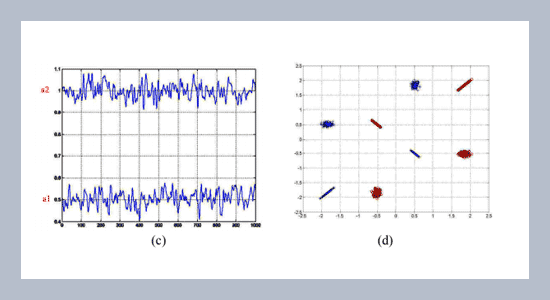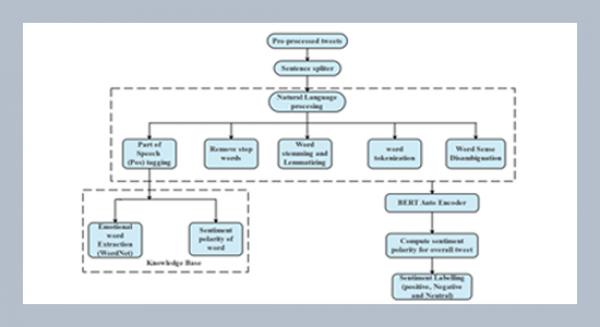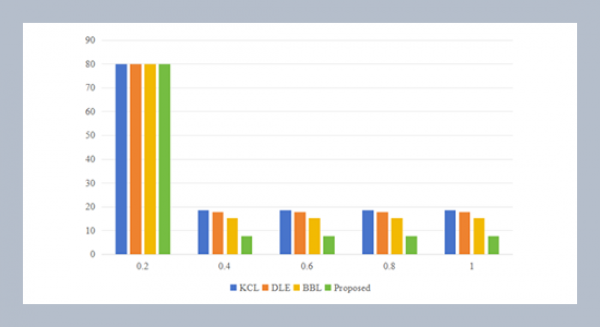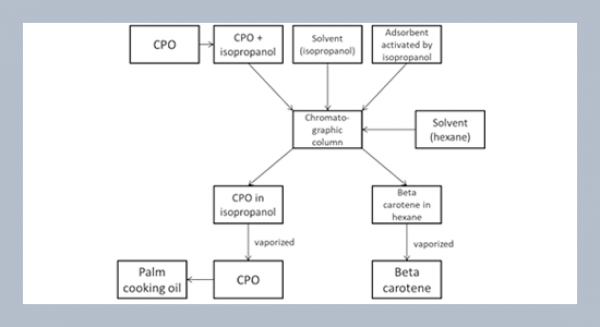Cheng-Jian Lina*, Shang-Jin Honga, and Chi-Yung Leeb a Department of Computer Science and Information Engineering, Chaoyang University of Technology, Wufong, Taichung County 41349, Taiwan, R.O.C.
b Department of Computer Science and Information Engineering, Nankai Institute of Technology, Caotun, Nantou County 542, Taiwan, R.O.C.
Download Citation:
|
Download PDF
Adaptive equalizers are used in digital communication system receivers to mitigate the effects of non-ideal channel characteristics and to obtain reliable data transmission. In this paper, we adopt least squares support vector machines (LS-SVM) for adaptive communication channel equalization. The LS-SVM involves equality instead of inequality constraints and works with a least squares cost function. Since the complexity and computational time of a LS-SVM equalizer are less than an optimal equalizer, the LS-SVM equalizer is suitable for adaptive digital communication and signal processing applications. Computer simulation results show that the bit error rate of the LS-SVM equalizer is very close to that of the optimal equalizer and better than multilayer perceptron (MLP) and wavelet neural network (WNN) equalizers.ABSTRACT
Keywords:
digital communication; adaptive equalizer; support vector machines; time-varying channel; kernel function.
Share this article with your colleagues
[1] Al-Mashouq, K. A. and I. S. Reed. 1994. The use of neural nets to combine equalization with decoding for severe intersymbol interference channels. IEEE Transactions on Neural Networks, 5, 6: 982-988.REFERENCES
[2] Chen, S., B. Mulgrew, and P. M. Grant. 1993. A clustering technique for digital communications channel equalization using radial basis function networks. IEEE Transactions on Neural Networks, 4, 4: 570-579.
[3] Liang, Q. and J. M. Mendel. 2000. Equalization of nonlinear time-varying channels using type-2 fuzzy adaptive filters. IEEE Transactions on Fuzzy Systems, 8, 5: 551 - 563.
[4] Jagdish, C. Patra and Ranendra N. Pal 1995. A functional link artificial neural network for adaptive channel equalization. Elsevier Science B. V. Signal Processing, 43: 181-195.
[5] Kechriotis, G. and E. S. Manolakos. 1994. Using recurrent neural networks for adaptive communication channel equalization. IEEE Transactions on Neural Networks, 5, 2: 267-278.
[6] Gibson, G. J. and C. G. N. Cowan. 1990. On the decision regions of multilayer perceptrons. Proceedings of the IEEE, 78: 1590-1594.
[7] Cristea, P., R. Tuduce, and A. Cristea. 2000. Time series prediction with wavelet neural networks. Proceedings of IEEE Neural Network Applications in Electrical Engineering.
[8]Zhang, J., G. G. Walter., Y. Miao, and W. N. W. Lee. 1995. Wavelet neural networks for function learning. IEEE Trans.
[9] Cortes, C. and V. Vapnik. 1995. Support vector networks. Machine Learning, 20, 3: 273-297.
[10] Muller, K.-R., S. Mika., G. Ratsch., K. Tsuda, and B. Scholkopf. 2001. An introduction to kernel-Based learning algorithms. IEEE Transactions on Neural Networks. 12, 2: 181-202.
[11] Suykens, J. A. K. and J. Vandewalle, 1999. Least squares support vector machine classifiers. Neural Processing Letters. 9, 3: 293-300.
[12] Cristianini, N. and J. Shawe-Taylor. 2000. “An introduction to support vector machines and other kernel based learning methods”. Cambrige University Press.
[13] Poggio, T. and F. Girosi. 1990. Networks for approximation and learning. Proceeding of the IEEE, 78, 9: 1481-1497.
[14] Vapnik, V. 1995. “The Nature of Statistical Learning Theory.”Springer-Verlag New York, Inc.
[15] El-Naqa, I., Y. Yang., M. N. Wernick., N. P. Galatsanos, and R. M. Nishikawa. 2002. A support vector machine approach for detection of microcalcifications. IEEE Transactions on Medical Imaging. 21, 12: 1552-1563.
[16] Valentini, G., M. Muselli, and F. Ruffino. 2003. Bagged ensembles of support vector machines for gene expression data analysis. Proceedings of the International Joint Conference on Neural Networks. 3: 20-24.
[17] Kim, K. I., K. Jung., S. H. Park, and H. J. Kim. 2002. Support vector machines for texture classification. IEEE Transactions on Pattern Analysis and Machine Intelligence. 24, 11:1542-1550.
[18] Malinowski, M., M. Jasin´ski, and M. P. Kazmierkowski. 2004. Simple direct power control of three-phase PWM rectifier using space-vector modulation (DPC-SVM). IEEE Transactions on Industrial Electronics. 51, 2:447-454.
[19]Suykens, J. A. K., L. Lukas, and J. Vandewalle. 2000. Sparse least squares support vector machine classifier. ESANN’2000 European Symposium on Artificial Neural Networks: 37-42.
[20] Maeda, Y. and R. J. P. De Figueiredo. 1997. Learning Rules for Neuro-Controller via Simultaneous Perturbation. IEEE Transaction on Neural Networks. 8, 5:1119-1130.
ARTICLE INFORMATION
Accepted:
2005-03-07
Available Online:
2005-04-03
Lin, C.-J., Hong, S.-J., Lee, C.-Y., 2005. Using least squares support vector machines for adaptive communication channel equalization. International Journal of Applied Science and Engineering, 3, 51–59. https://doi.org/10.6703/IJASE.2005.3(1).51
Cite this article:















